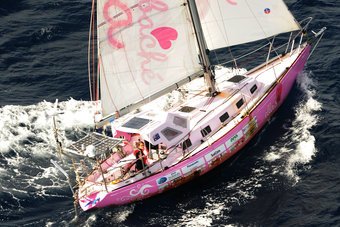A 16 old Australian named Jessica Watson recently completed an around-the-world solo sailing voyage. Apparently, there has been some grumbling from certain quarters about her route not exactly meeting the official circumnavigational standards, but no one can deny that she is a tough kid.
Jessica sailed 23,000 nautical miles non-stop in 7 months, unassisted. Her 34ft. vessel was knocked over several times. Alone she battled forty foot waves and the less visible challenges of fear, loneliness and exhaustion. She received a hero’s welcome on arrival back in Sydney and, among other things, said she looks forward to getting her driver’s license. They should just give it to her.
I asked my tenth graders, exactly Jessica’s age, for their reactions. What struck them most was the fact that her parents had allowed her to make the attempt. They were impressed with Jessica’s feat but tended to see the Watson’s decision to support Jessica’s plan as irresponsible, at least at first. Interestingly, I didn’t hear a single, “Gee, I wish my mom and dad would let me do that.”
Since they were obviously focused on the risks involved, I asked what they thought would have happened if Jessica had died in the attempt? Would there have still have been a story? Probably, they concluded, led by a chorus of loud recriminations and claims of gross parental negligence.
We all agreed that fingers would have been pointed and people would have demanded to know who had signed off on such an obviously dangerous voyage. There would have been pressure to prosecute Jessica’s mother and father for recklessly endangering their daughter’s life. Someone might even have gone so far as to suggest that a law be passed, so that a thing like this couldn’t happen again. “Safety first” has become the 21st century mantra.
We watched footage of Jessica’s return and discussed the role of chance in her seven month odyssey. She could have been slammed by a rogue wave and disappeared somewhere in the middle of the Pacific, but freak accidents can happen on land or sea. In the event, she not only survived, she thrived. Her ability to meet the technical, meteorological and emotional challenges of her 210 day trip certainly makes the case for her extraordinary skills as a sailor, not to mention her maturity and strength as a person. No one could be remotely that lucky.
The story we read noted that among those waiting to greet her was a fellow Australian, a boy, Jesse Martin, who completed his around-the-world solo at 17. One of my students, a girl, wondered whether Jessica’s trip would be drawing as much attention, if she too were a boy. The student picked up the not so subtle insinuation that as a girl Jessica somehow deserved more credit for her feat and, paradoxically, her parents more blame for letting her try it. Sexism persists. Of course, we need to have certain standards, a legal driving age, for example, but whenever possible why not simply judge people on how well they perform?
In sailing, as in many other areas, technology is a powerful leveler. Winches and pulleys make differences in peak physical strength relatively insignificant. Psychological and physical endurance on the other hand matter a lot. In the world of ultra-long distance running and swimming, for example, women draw closer to men as the races lengthen. In a seven month marathon of the sort Jessica undertook, maybe girls have an advantage.
Jessica was clearly prepared. She accepted the risks as the price of the adventure, and she didn’t limp home, she bounded. She also gave my students a lot to think about.


One area I believe the media has dropped the ball on this story, is any mention of all the preparation that went into her journey around the world. It almost sounds as though, she just decided to hop in a boat and sail around the world – which would be just plain suicide.
Without a compete story of years of preparation and the support in her journey around the world, we are seeing an incomplete picture of her journey. That said, I do have to agree that our society is moving too far towards a “safety first” mentality – most troubling in a way that ignores real dangers over one off incidents of danger.
At the tender age of 17, my father-in-law graduated from high school and enlisted in the navy “for the duration” of WWII. After a few weeks of basic training, he was sent to fight in the South Pacific.
Jessica has been training for this for 5 years. She had sailed over 6,000 NM, taken several courses and certifications, and studied many hours on diesel mechanics and navigation before setting out on her journey. I dare say she was better prepared for her undertaking than my father-in-law, who also survived, was in his.
I followed Jessica with enthusiasm for many months as I am a beginning sailor. My sailing instructors all agreed that one should never sail alone in open water, but I am in awe of her accomplishment.
Your posting about Jessica Watson was really interesting, because I’ve had these discussions with other parents regarding Amy Sunderland and what you can “let” your kid do at what age. At 16, anyone can drive. At 18, anyone can do anything except drink alcohol, and that includes volunteering for near-suicide missions in the military. So why wouldn’t an experienced and precocious 16-year-old be able to make up her own mind about sailing around the world? I really don’t know the answer, but I was fascinated by what your tenth-graders had to say about it.